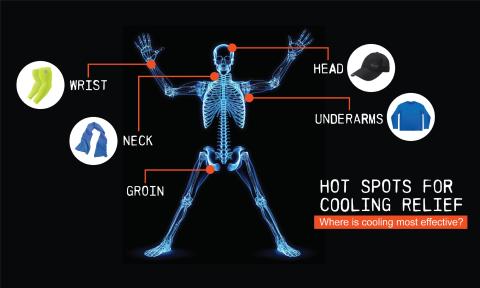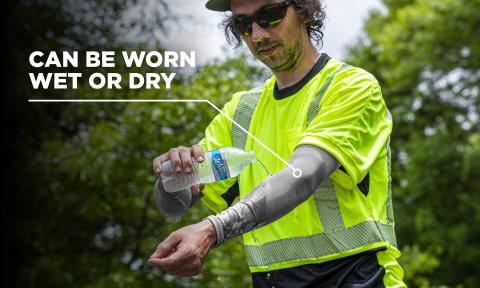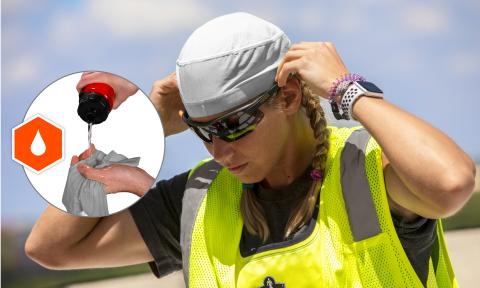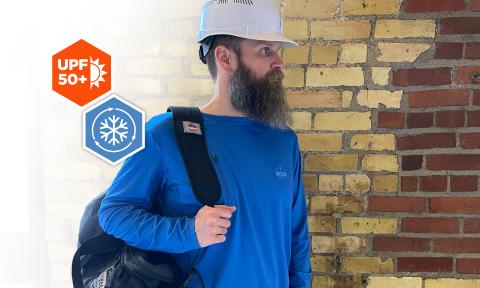Pulse Points: Your Hot Spots For Cooling Relief

Did you know your body comes with a nifty, built-in heat stress hack? Yup. When the world goes volcanic, you've got a trick up your (cooling) sleeve, thanks to a few strategic spots known as pulse points.
UNDERSTANDING HEAT STRESS AND ITS DANGERS
Heat stress occurs when the body's internal cooling mechanisms, like sweating and blood circulation, are overwhelmed, unable to sufficiently cool the body. This can lead to heat exhaustion, heatstroke, and other severe health complications. Workers in fields such as construction, manufacturing, and agriculture are especially vulnerable to these risks due to prolonged exposure to high temperatures.
The Bureau of Labor Statistics (BLS) reports 1,000s of injuries and about 40 deaths on the job every year, but “occupational heat-related illnesses, injuries, and fatalities may be underestimated” according to the Occupational Safety and Health Administration (OSHA).
Here’s an example 👉 An analysis of more than 11 million workers’ compensation injury reports in California from 2001 through 2018 found that working on days with hotter temperatures likely caused about 20,000 injuries and illnesses per year in that state ALONE.
That’s 300 times the annual injuries and illnesses California OSHA (Cal/OSHA) attributes to heat.
Three. Hundred. Times.
No typo.
Three-zero-zero.
So what gives?
Well, here’s a biggie: folks much smarter than us have proven time and time again that heat melts away the brain’s ability to do brain things at peak capacity. Reduced cognitive and physical functioning from the heat leads to recordables under another name . . . like, say, a “slip, trip or fall”. Meanwhile, the true instigator keeps a clean record. That heat stress is a real stinker.
For more on the who/what/where/why/when of heat stress, head over to our wonderfully curated heat stress hazard page and bookmark that baby. Super useful.
WHAT ARE PULSE POINTS AND HOW DO THEY HELP YOU COOL DOWN?
Effective heat management goes beyond comfort, directly impacting workers' safety and productivity. Keeping core body temperatures within safe limits prevents heat stress and enhances cognitive and physical performance, essential for safety and efficiency in high-temperature work settings.
The body has two primary mechanisms to cool itself when it heats up: vasodilation and perspiration (read more about that here).
Vasodilation involves the widening of blood vessels, which increases blood flow through them. In response to heat, the blood vessels near the skin's surface expand, allowing more blood to reach the body’s exterior where it can release heat, provided the external temperature is below the body’s core temperature.
This cooler blood then moves back to the center of the body, where it helps to lower the core temperature by absorbing heat. This process operates similarly to the cooling systems used in refrigerators and car engines, where a liquid coolant circulates through the system, absorbs heat, and is then cycled back out to cool in the ambient air.
Pulse points, where blood vessels are close to the surface, can cool your blood and, by extension, your entire body, quicker than you can say "ice ice baby". Located at your head, neck, underarms, wrists and groin, these spots are your go-to zones for quick cool-downs. Pair those pulse points with cooling PPE (Personal Protective Equipment) and you've got yourself an invigorating cooling effect rivaled only by the feeling of biting into a York Peppermint Patty.
PAIRING PULSE POINTS WITH YOUR COOLING PPE
What we’re saying is, anybody with a pulse can stay cool. Deploying cooling PPE on these strategic points helps take the edge off the broiling heat.

Pulse Point: Neck
Cooling PPE Recommendation: Cooling towels, gaiters, neck shades

Pulse Point: Wrists
Cooling PPE Recommendation: Cooling sleeves, shirts, multi-bands

Pulse Point: Temples and Forehead
Cooling PPE Recommendation: Cooling hats, skull caps, headbands, multi-bands, hard hat pads + liners

Pulse Point: Underarms
Cooling PPE Recommendation: Cooling shirts

FIND YOUR CHILL: WHAT COOLING TECHNOLOGY IS RIGHT FOR ME?
Chill-Its Cooling Technology transports sweet relief light years beyond frozen washcloths and clunky ice packs. But you have options… wet evaporative, dry evaporative, phase change… and not every option is appropriate for every work setting.
Take a peek at the video below and then head on over here to find what cooling option is right for you and your team.
When it comes to Heat Stress Prevention, OSHA’s Water, Rest and Shade Guidelines are really just the start. While it does lay the groundwork, a complete program goes beyond the basics to also include advanced cooling technologies to keep workers safe both outdoors as well as in. So let’s break down the two main types of cooling PPE and technologies, and talk about how easy they are to use and when and where you would utilize each.
Let’s start with Evaporative Cooling Technology. Evaporative Cooling Technology is going to be ideal for someone working in an environment with adequate airflow and also low-to-moderate humidity levels. To activate an Evaporative Cooling Product, you are going to want to fully saturate the product in water and then expose it to airflow. It’s that easy. Once activated, you’re going to get up to four hours of cooling with that product.
Evaporative Cooling Products come in a variety of different models and styles. You can find them in vest form to help regulate your core body temperature even better or you can find it in accessories—whether that be cooling bandanas, cooling towels or hard hat attachment accessories.
There’s one additional type of Evaporative Cooling Technology that I wanted to touch on and that’s Dry Evaporative Technology. Dry Evaporative Cooling Technology is different from Wet Evaporative in that the wearer stays dry 100% of the time. Just as easy to activate by filling the vest with water, and then you’re going to get up to three days of cooling with that cooling technology.
Moving on to Phase Change… We know it’s not a one-size-fits-all approach and there are workers in a variety of different environments. Those who are working in high heat environments like manufacturing, foundries and bakeries, to name a few, or those who are wearing layers of PPE and do not have access to airflow are going to benefit from a Phase Change Cooling Technology. What’s great about Phase Change is, regardless of environmental variables, once activated, it’s going to stay cool for between two and four hours.
Now, Phase Change packs are easy to activate. Your simply soak them in a bucket of ice water, put them in the refrigerator or a cooler for up to 15 minutes. And as I said, once activated, you don’t have to worry about humidity or airflow. You can wear it under your PPE and you’re going to stay cool for 2 to 4 hours.
For more information on Cooling PPE and Heat Stress Basic Awareness, search Heat Stress on our Tenacious Blog at Ergodyne.com
WAIT! BEFORE YOU GO… QUICK COOLING TACTICS
Don’t let the heat dictate your day—take control with a Chill-Its cooling strategy.
- Preemptive Cooling: Equip yourself with Chill-Its gear at the start of your day to keep the heat from ever taking hold.
- Stay Hydrated: Hydration helps regulate everything in your body… including temp control.
- Scheduled Breaks: Reactivating your Chill-Its gear on breaks helps maintain its effectiveness. It’s not just a break for you; it’s a cooldown period for your gear too.
FAQ
The body's pulse points are located on the head, neck, wrist, underarms, and groin.
The body uses pulse points to cool down through the process of heat exchange. Here's how it works:
- Proximity to Blood Vessels: Pulse points are areas where blood vessels are close to the skin's surface
- Heat Dissipation: When these areas are cooled (e.g., with cold packs, water, or cooling towels), the temperature of the blood in those vessels is reduced
- Circulation: As the cooler blood circulates through the body, it helps lower the overall body temperature
- Evaporation: If the cooling method involves moisture (like wet towels or evaporative cooling gear), the evaporation process further cools the skin and underlying blood vessels
- Efficiency: By targeting these specific points, the body can efficiently dissipate heat, helping to maintain a stable and lower core temperature
Cooling down internal body heat can be achieved through several methods:
- Hydration: Consume plenty of water to regulate body temperature and replace fluids lost through sweating, and use sports drinks to replenish electrolytes and maintain proper hydration.
- Cooling Pulse Points: Use ice packs, cold compresses, or cooling towels on pulse points such as the neck, wrists, and behind the knees.
- Environment: Spend time in air-conditioned or shaded areas to avoid excessive heat exposure, and use fans to circulate air and enhance the cooling effect on the skin.
- Appropriate Clothing: If possible, choose UPF rated clothing to help with feeling cooler and provide further protection against the sun.
- Physical Activity: Avoid intense physical activity during the hottest parts of the day and take frequent breaks in a cool environment if physical activity is necessary.
- Cool Baths or Showers: Immerse yourself in a cool bath or take a cool shower to lower your core body temperature.
- Evaporative Cooling Gear: Use evaporative cooling vests or other cooling gear designed to keep your body temperature down during heat exposure.

